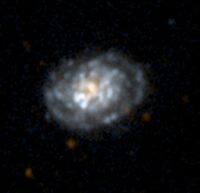Astronomy:NGC 5962
| NGC 5962 | |
|---|---|
 NGC 5962, 32 inch Schulman Foundation telescope on Mt. Lemmon, AZ | |
| Observation data (J2000 epoch) | |
| Constellation | Serpens Caput |
| Right ascension | 15h 36m 31.681s[1] |
| Declination | +16° 36′ 27.93″[1] |
| Helio radial velocity | 1,957 km/s[2] |
| Distance | 119.5 Mly (36.64 Mpc)[2] |
| Group or cluster | NGC 5962/5970 group[3] |
| Apparent magnitude (V) | 11.34[4] |
| Apparent magnitude (B) | 11.98[4] |
| Characteristics | |
| Type | SAB(rs,nrl)c[5] |
| Apparent size (V) | 1.490′ × 1.073′[6] (NIR) |
| Other designations | |
| NGC 5962, UGC 9926, MCG+03-40-011, PGC 55588[7][8] | |
NGC 5962 is a spiral galaxy in the equatorial constellation of Serpens Caput. It was discovered by the Anglo-German astronomer William Herschel on March 21, 1784.[9] The NGC 5962 galaxy is located at a distance of 120 million light years and is receding with a heliocentric radial velocity of 1,957 km/s.[2] It is the brightest member of the eponymously-named NGC 5962 group, which overlaps with the nearby NGC 5970 group; the two groups may be gravitationally bound.[3]
The morphological (shape) class of NGC 5962 in the infrared is SAB(rs,nrl)c. This notation indicates the galaxy has a bar structure around the nucleus (SAB), an inner pseudo-ring likely associated with the outer Lindblad resonance (rs), a ring-lens structure at the nucleus (nrl), and loosely-wound spiral arms (c).[5] In the optical band, this galaxy is classed as Hubble type SA(r)c,[10] displaying an inner ring with no visible bar. The galactic plane is inclined at an angle of 45°±2° to the line of sight from the Earth, giving it an oval profile with the major axis aligned along a position angle of 109°±4°.[11]
Along with a populated nucleus, it has a relatively large core, but a small central bulge, in which the spiral arms begin to unfurl. There is some evidence for a low level of nuclear activity, and it has been classed as a nuclear H II region galaxy.[10] Based on its emission of far ultraviolet radiation, the pseudo-ring structure is actively undergoing star formation.[12] The galaxy is forming stars at the rate of 6 M☉·yr−1.[13] There are two confirmed satellite galaxies; a third candidate proved to be too distant based on its redshift value.[14]
Two supernovae have been detected in this galaxy: SN 2016afa (type II, mag. 17.1)[15] was discovered February 12, 2016, and SN 2017ivu (type IIP, mag. 15.4)[16] was spotted December 11, 2017.[17]
References
- ↑ 1.0 1.1 Brown, A. G. A. (August 2018). "Gaia Data Release 2: Summary of the contents and survey properties". Astronomy & Astrophysics 616: A1. doi:10.1051/0004-6361/201833051. Bibcode: 2018A&A...616A...1G. Gaia DR2 record for this source at VizieR.
- ↑ 2.0 2.1 2.2 Tully, R. Brent et al. (2016). "Cosmicflows-3". The Astronomical Journal 152 (2): 21. doi:10.3847/0004-6256/152/2/50. 50. Bibcode: 2016AJ....152...50T.
- ↑ 3.0 3.1 Zwaan, Martin A. (August 2001). "A targeted survey for H i clouds in galaxy groups". Monthly Notices of the Royal Astronomical Society 325 (3): 1142–1148. doi:10.1046/j.1365-8711.2001.04514.x. Bibcode: 2001MNRAS.325.1142Z.
- ↑ 4.0 4.1 Gil de Paz, Armando et al. (December 2007). "The GALEX Ultraviolet Atlas of Nearby Galaxies". The Astrophysical Journal Supplement Series 173 (2): 185–255. doi:10.1086/516636. Bibcode: 2007ApJS..173..185G.
- ↑ 5.0 5.1 Herrera-Endoqui, M. et al. (October 2015). "Catalogue of the morphological features in the Spitzer Survey of Stellar Structure in Galaxies (S4G)". Astronomy & Astrophysics 582: 16. doi:10.1051/0004-6361/201526047. A86. Bibcode: 2015A&A...582A..86H.
- ↑ Skrutskie, Michael F. et al. (1 February 2006). "The Two Micron All Sky Survey (2MASS)". The Astronomical Journal 131 (2): 1163–1183. doi:10.1086/498708. ISSN 0004-6256. Bibcode: 2006AJ....131.1163S.
- ↑ "NASA/IPAC Extragalactic Database". Results for NGC 5962. http://nedwww.ipac.caltech.edu/.
- ↑ "NGC 5962". SIMBAD. Centre de données astronomiques de Strasbourg. http://simbad.u-strasbg.fr/simbad/sim-basic?Ident=NGC+5962.
- ↑ Seligman, Courtney. "NGC Objects: NGC 5950 - 5999". Celestial Atlas. https://cseligman.com/text/atlas/ngc59a.htm#5962.
- ↑ 10.0 10.1 Misselt, K. A. et al. (November 1999). "Optical Long-Slit Spectroscopy of a Sample of Spiral Galaxies". The Publications of the Astronomical Society of the Pacific 111 (765): 1398–1409. doi:10.1086/316450. Bibcode: 1999PASP..111.1398M.
- ↑ García-Gómez, C. et al. (July 2004). "Deprojecting spiral galaxies using Fourier analysis. Application to the Ohio sample". Astronomy and Astrophysics 421 (2): 595–601. doi:10.1051/0004-6361:20035735. Bibcode: 2004A&A...421..595G.
- ↑ Comerón, S. (July 2013). "Inner rings in disc galaxies: dead or alive". Astronomy & Astrophysics 555: 9. doi:10.1051/0004-6361/201321983. L4. Bibcode: 2013A&A...555L...4C.
- ↑ Misiriotis, A. et al. (April 2004). "Dust masses and star formation in bright IRAS galaxies. Application of a physical model for the interpretation of FIR observations". Astronomy and Astrophysics 417: 39–50. doi:10.1051/0004-6361:20035602. Bibcode: 2004A&A...417...39M.
- ↑ Mao, Yao-Yuan et al. (February 2021). "The SAGA Survey. II. Building a Statistical Sample of Satellite Systems around Milky Way-like Galaxies". The Astrophysical Journal 907 (2): 35. doi:10.3847/1538-4357/abce58. 85. Bibcode: 2021ApJ...907...85M.
- ↑ Transient Name Server entry for SN 2016afa. Retrieved 24 March 2023.
- ↑ Transient Name Server entry for SN 2017ivu. Retrieved 24 March 2023.
- ↑ Im, Myungshin et al. (February 2019). "Intensive Monitoring Survey of Nearby Galaxies (IMSNG)". Journal of the Korean Astronomical Society 52 (1): 11–21. doi:10.5303/JKAS.2019.52.1.11. Bibcode: 2019JKAS...52...11I.
External links
 |


